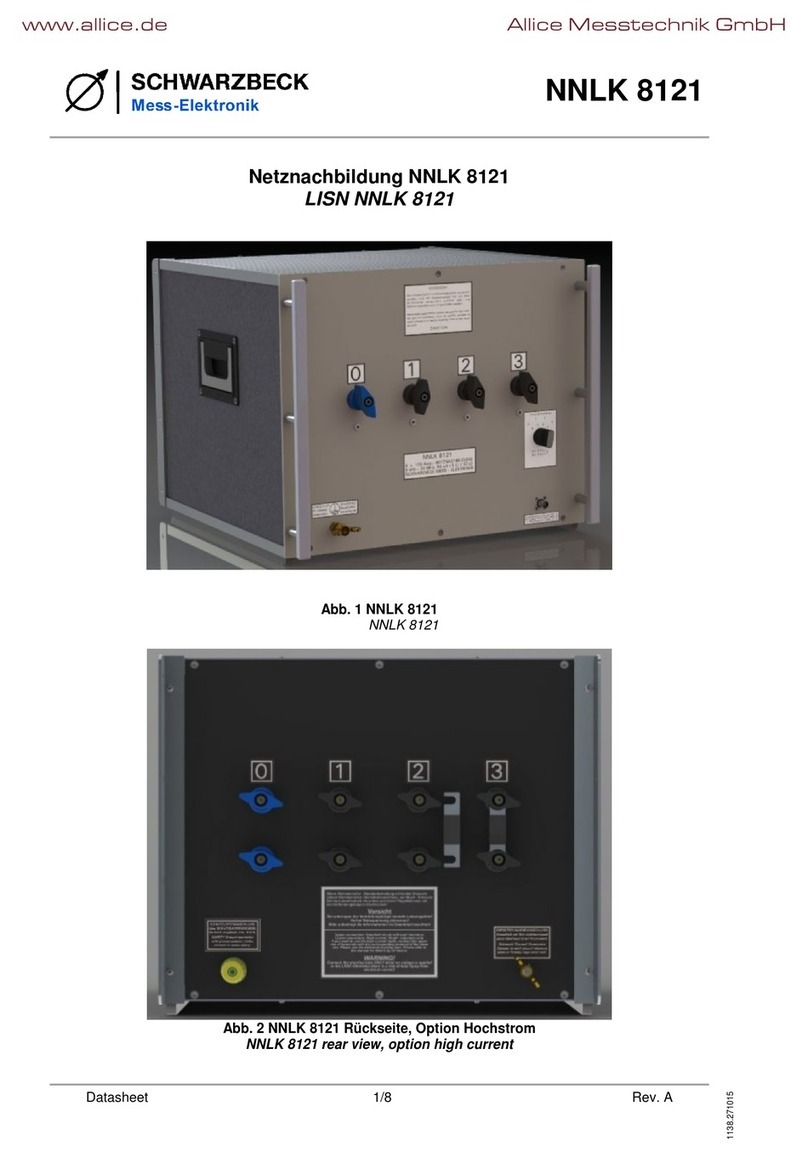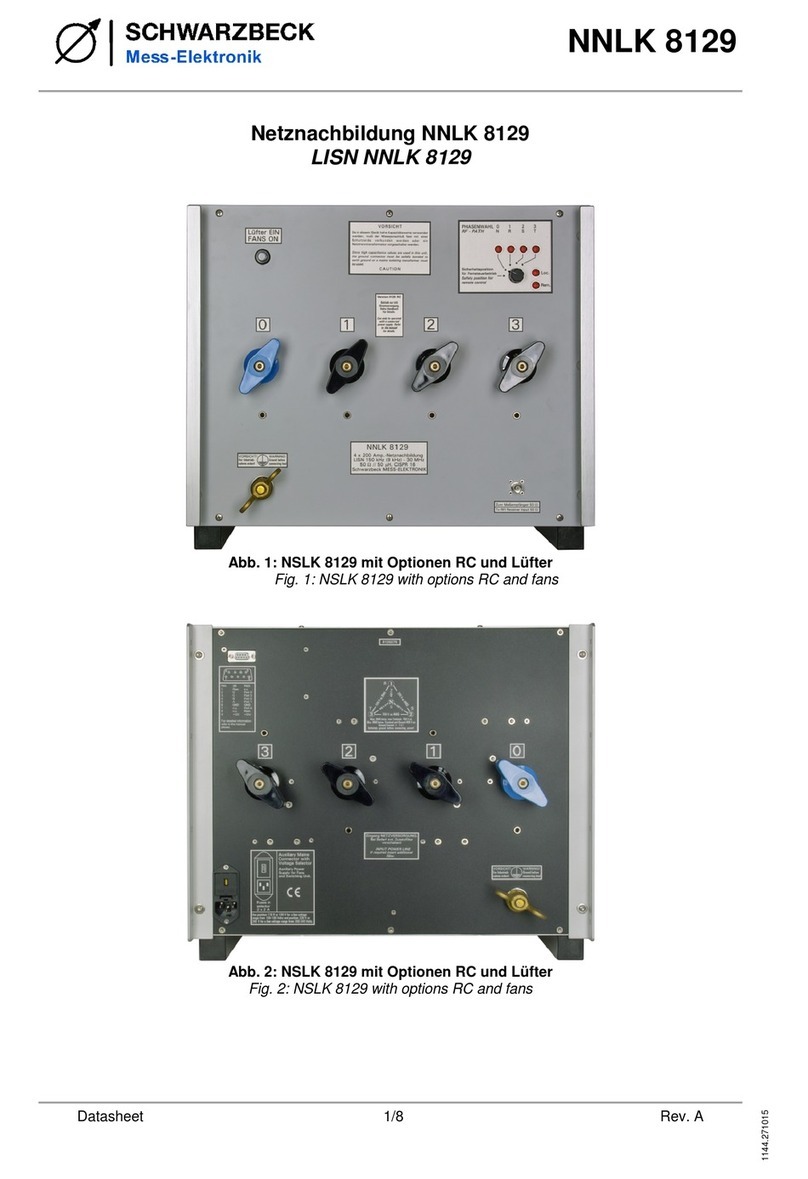
NTFM 8158
Datasheet 3/7 Rev. G
1614.080420
Anwendung: Application:
Der Telekommunikationsanschluss des
Prüflings wird an die EuT-Seite angeschlossen.
Die NTFM 8158 stellt damit die asymmetrische
Leitungsabschlussimpedanz des Prüflings dar.
Hilfsgeräte oder Zusatzeinrichtungen, die mit
dem Prüfling betrieben werden müssen, werden
an den Anschluss AE (=Auxiliary Equipment)
angeschlossen.
The telecommunication port of the device
under test must be connected to the NTFM
8158 EuT-port. The NTFM 8158 provides the
asymmetrical port termination of the EuT.
Auxiliary Equipment (AE) which has to be
operated together with the device under test
must be connected to the AE-port of
NTFM 8158.
Die Übertragung von Daten erfolgt durch
symmetrische Nutzsignale auf Leitungspaaren.
Verschiebt sich der virtuelle Nullpunkt eines
Leitungspaars gegen Bezugsmasse, spricht
man von asymmetrischer Störspannung oder
Gleichtaktstörung. Diese werden an die BNC
Buchse der NTFM 8158 ausgekoppelt. Das
nominelle Spannungsteilungsmaß beträgt dabei
ca. 10 dB. Die mit einem 50 ΩMessempfänger
angezeigte Spannung muss also um 10 dB
erhöht werden, um die Störspannung zu
errechnen.
The data communication is based on
differential mode voltages on pairs of wires. If
the virtual null in the electrical middle of the
voltages shifts compared to reference ground
the magnitude of this shift is called the
asymmetrical disturbance voltage or the
common mode voltage. This voltage is
decoupled to the BNC-connector to be
measured with a receiver. The nominal
voltage division factor is 10 dB, i.e. the
reading of the voltage at a 50 Ωreceiver has
to be increased by 10 dB. This results into
the disturbance voltage.
Die Unsymmetriedämpfung beschreibt, in
welchem Maß das differentielle (Gegentakt-)
Nutzsignal der Datenübertragung entlang einer
Übertragungsleitung in ein (unerwünschtes)
Gleichtakt-Signal umgewandelt wird.
Gleichtaktsignale können abgestrahlt werden
und daher Störungen verursachen.
The LCL describes the conversion of the
wanted differential mode data signal along a
transmission line into an unwanted common
mode signal. The common mode signal could
be radiated and might cause disturbance
field strength.
Details zum Prüfaufbau sind in CISPR 22
bebildert und beschrieben. Besondere
Beachtung ist dabei induktivitätsarmer, d.h.
hochfrequenzmäßig niederohmiger Verbindung
mit der Bezugsmassefläche zu schenken. Dies
wird durch direktes, flächiges Auflegen des
Aluminiumgehäuses der NTFM 8158 auf die
Bezugsmassefläche erreicht. AE- und EuT-
Kabel dürfen nicht parallel geführt werden, um
die gute Entkopplung der NTFM 8158 zu
erhalten.
The test set up is described in CISPR 22
more detailed. Special attention must be paid
to low inductive grounding, i.e. grounding
suitable for radio frequencies. This is
achieved by placing the aluminium housing
of the NTFM 8158 directly on the reference
ground plane. The EuT cable and the AE
cable must not be installed close or parallel
to each other to avoid unwanted coupling
between them.
Anschlussbelegung Pin assignment
Die Steckerbelegung erfolgt nach EIA/TIA-
T568A/B. RJ-12 und RJ-14 Stecker verwenden
Paar 1 und Paar 3, RJ-11 Stecker verwenden
Paar 1, da diese in der RJ-45 Buchse in der
Mitte liegen, wobei Pin 1 und 6 des RJ-12
Steckers nicht benutzt werden können. Bitte
beachten Sie, dass die Lebensdauer der RJ-45
Buchse bei Verwendung von RJ-12-, RJ-11-
oder RJ-14 Steckern erheblich abnimmt.
The Pin Assignment complies to EIA/TIA-
T568A/B. RJ-12 and RJ-14 connectors use
pair 1 and pair 3, RJ-11 connectors use pair
1 of the RJ-45 jack which are located in the
middle of the RJ-45 connector. Pins 1 and 6
of the RJ-12 are not useable then. Please
note that using RJ-12, RJ-11 or RJ-14
connectors in RJ-45 jacks leads to
decreased lifespan of the RJ-45 jack.
Wird an weniger als 4 Leitungspaaren
gemessen, werden die unbenutzten Adern
freigelassen.
If less than four pairs are measured, the
unused wires are left unconnected.


























